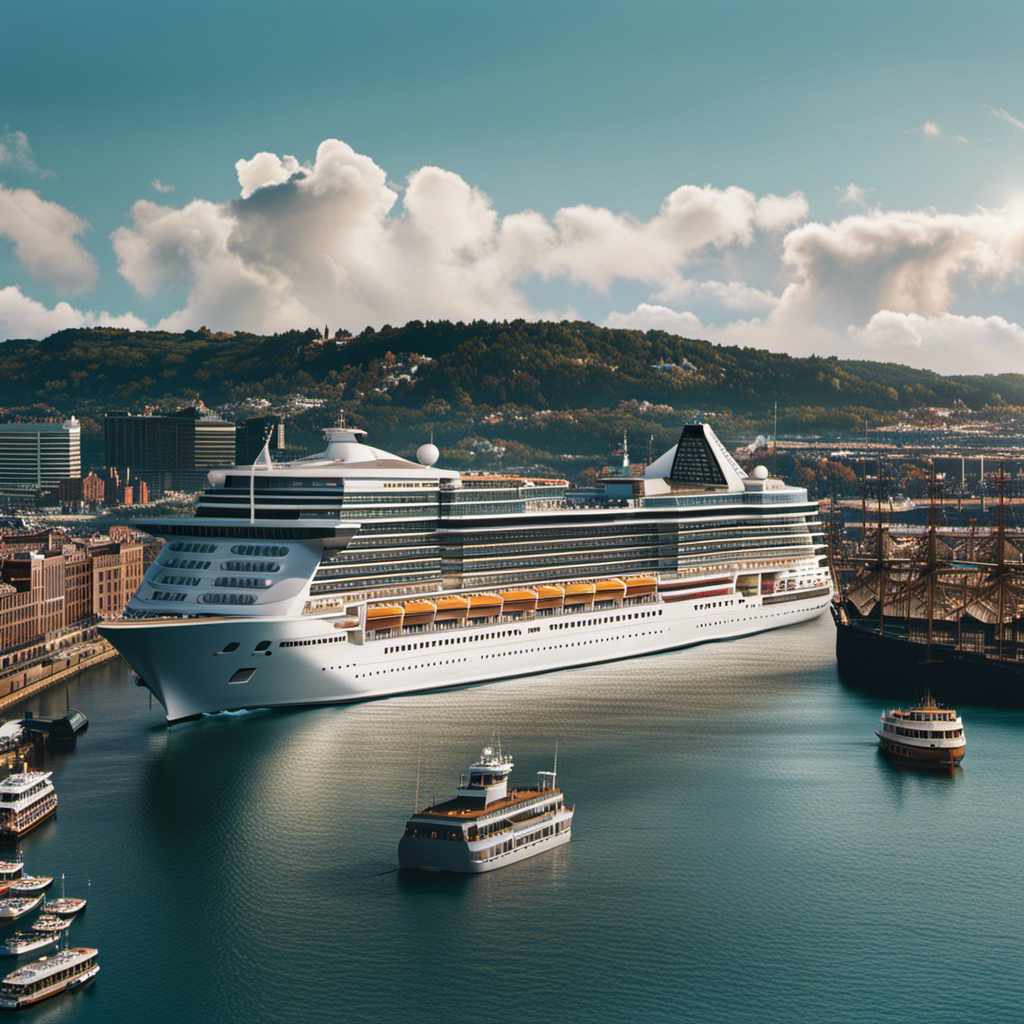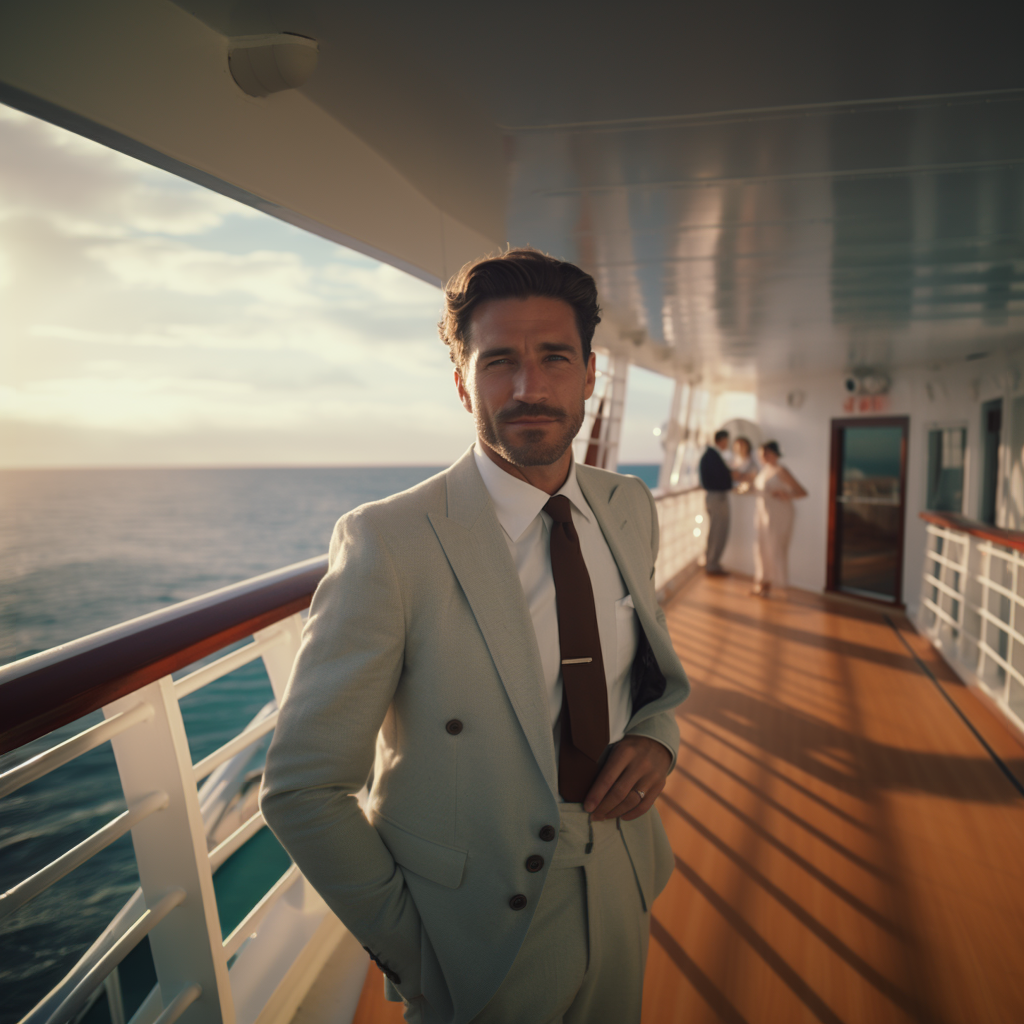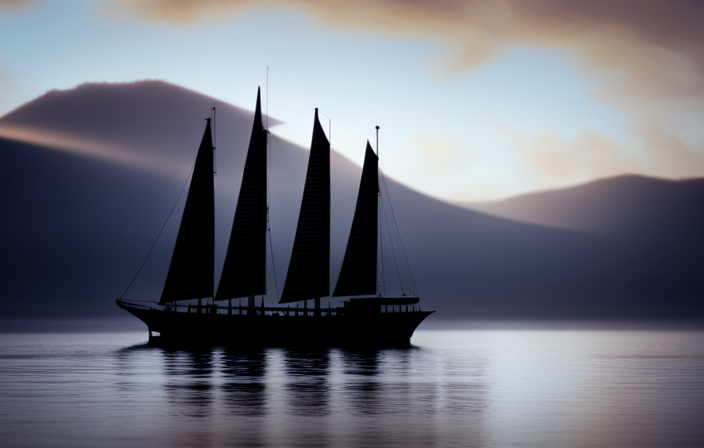I’ve always been fascinated by the immense size and weight of cruise ships. It’s incredible to think about the huge dimensions of these floating cities and the marvels of engineering that make their existence possible.
In this article, we’ll delve into the world of cruise ship weight, exploring the factors that contribute to it, its impact on stability and safety, and even its influence on fuel consumption.
Get ready to dive into the technical details of how much cruise ships really weigh.
Key Takeaways
- Cruise ship weight is crucial for safety, navigation, and fuel consumption.
- Factors contributing to cruise ship weight include passenger capacity, fuel, water, amenities, and structural design.
- The average weight range of cruise ships varies depending on size and class.
- Cruise ship weight directly affects stability, safety, buoyancy, and carbon emissions.
The Importance of Knowing the Weight of Cruise Ships
Knowing the weight of cruise ships is crucial for safety and navigation purposes. Weight management plays a significant role in ensuring the overall stability and maneuverability of these massive vessels. It is essential to understand the impact of weight on environmental sustainability as well.
The importance of weight management in cruise ship operations cannot be overstated. Excessive weight can negatively affect fuel efficiency, leading to increased carbon emissions and environmental harm. By accurately measuring and managing the weight of cruise ships, operators can optimize fuel consumption and minimize their carbon footprint.
Understanding the factors that contribute to cruise ship weight is the first step towards effective weight management. These factors include the ship’s structure, machinery, fuel, provisions, and passenger and cargo loads. Each element must be carefully considered to maintain the ship’s stability and ensure safe and environmentally responsible operation.
Understanding the Factors That Contribute to Cruise Ship Weight
To understand what makes cruise ships heavy, you need to consider various factors. Here are four key factors that affect cruise ship weight and can have a significant impact on ship performance:
-
Passenger Capacity: The number of passengers a cruise ship can accommodate directly affects its weight. More passengers mean more weight in terms of cabins, amenities, and supplies.
-
Fuel and Water: Cruise ships carry large amounts of fuel and water to sustain their operations during voyages. These can add significant weight to the ship, impacting its overall weight and stability.
-
Amenities and Facilities: Cruise ships are equipped with various amenities such as restaurants, theaters, swimming pools, and gyms. These facilities contribute to the ship’s weight, as they require additional materials and equipment.
-
Structural Design: The materials used in the construction of a cruise ship, such as steel and other alloys, can significantly impact its weight. The structural design and engineering considerations also play a crucial role in determining the ship’s weight.
Considering these factors, it becomes evident that the weight of a cruise ship is influenced by multiple elements. The impact of weight on ship performance will be explored further in the subsequent section, which takes a look at the average weight range of cruise ships.
A Look at the Average Weight Range of Cruise Ships
The average weight range of cruise ships can vary depending on several factors. These factors include the size and design of the ship, the materials used in its construction, the onboard amenities and facilities, and the amount of fuel and supplies carried. To give you an idea of the weight range, here is a table showcasing the average weights of different types of cruise ships:
| Ship Type | Average Weight Range (in tons) |
|---|---|
| Small Cruise Ships | 1,000 – 10,000 |
| Medium Cruise Ships | 10,000 – 50,000 |
| Large Cruise Ships | 50,000 – 200,000 |
As you can see, cruise ships can range in weight from 1,000 tons to 200,000 tons, depending on their size and class. Understanding these average weight ranges is important because it impacts the stability and safety of the ship.
How Cruise Ship Weight Impacts Stability and Safety
When it comes to cruise ships, weight plays a crucial role in determining their stability and safety.
The weight and buoyancy of a ship are directly linked, as the ship needs to displace enough water to stay afloat.
Additionally, the distribution of weight on a cruise ship is essential for maintaining stability and preventing capsizing.
Lastly, safety considerations with weight include factors such as cargo load limits, passenger capacity, and the overall structural integrity of the ship to ensure a safe and comfortable voyage.
Weight and Buoyancy
Cruise ships are buoyant due to the displacement of water. The weight of a cruise ship plays a crucial role in determining its displacement and, consequently, its buoyancy. The displacement of water is directly proportional to the weight of the ship. As the ship’s weight increases, it displaces more water, resulting in greater buoyancy.
However, the weight of cruise ships also has an environmental impact. The heavier the ship, the more fuel it requires to propel it through the water, leading to increased greenhouse gas emissions and contributing to climate change. Therefore, reducing the weight of cruise ships can have a positive environmental impact by decreasing fuel consumption and emissions.
This brings us to the next section, where we will explore the importance of stability and weight distribution in ensuring the safe operation of cruise ships.
Stability and Weight Distribution
Stability and weight distribution are crucial factors in ensuring the safe operation of cruise ships. To maintain stability, a thorough stability analysis is conducted during the ship’s design phase. This analysis considers factors such as the ship’s weight capacity and the distribution of that weight.
Weight distribution is important to prevent the ship from listing to one side or becoming top-heavy. The ship’s weight is carefully distributed throughout different compartments, including fuel tanks, cargo holds, and passenger areas. Additionally, ballast tanks are used to adjust the ship’s center of gravity and maintain stability.
Safety considerations with weight involve monitoring the ship’s load and ensuring it stays within safe limits. This includes monitoring passenger and cargo weight, as well as fuel and water levels.
Safety Considerations With Weight
Safety considerations with weight on cruise ships include monitoring and managing passenger and cargo loads to ensure they stay within safe limits. Adhering to safety regulations is crucial to prevent accidents and maintain the stability of the vessel. To achieve this, weight distribution analysis is performed, taking into account the following factors:
-
Passenger Load: The number of passengers and their distribution throughout the ship must be carefully monitored. Safety regulations dictate the maximum capacity for each area to prevent overcrowding and maintain stability.
-
Cargo Management: Proper loading and distribution of cargo is essential to maintain the ship’s balance. Cargo weight, density, and placement are all considered during the weight distribution analysis.
-
Ballasting: Balancing the weight distribution through ballasting is a common practice. This involves adjusting the amount of water in the ballast tanks to ensure the ship remains stable in various sea conditions.
Understanding these safety considerations and implementing appropriate weight management measures is vital in ensuring the safety and stability of cruise ships. Now, let’s explore the different types of cruise ship weight measurements.
Exploring the Different Types of Cruise Ship Weight Measurements
When it comes to understanding the weight of different types of cruise ships, you might be surprised by the various measurements used. Cruise ship weight is typically measured using multiple techniques to ensure accuracy and precision.
One common method is deadweight tonnage (DWT), which refers to the total weight a ship can carry, including cargo, fuel, and passengers. Another measurement is gross tonnage (GT), which calculates the total internal volume of the ship.
The impact of weight on cruise ship performance cannot be underestimated. Excess weight can affect a ship’s stability, maneuverability, and speed. It can also impact fuel consumption, as a heavier ship requires more fuel to propel.
Understanding these weight measurement techniques and their effects on cruise ship performance is crucial to ensuring optimal efficiency and safety. Moving forward, let’s delve into the impact of cruise ship weight on fuel consumption.
The Impact of Cruise Ship Weight on Fuel Consumption
Understanding how cruise ship weight affects fuel consumption is essential for optimizing efficiency and reducing costs. The impact of weight on environmental sustainability cannot be underestimated.
Every extra pound on a cruise ship has a direct effect on the amount of fuel required to propel it through the water. The more fuel consumed, the greater the emissions released into the atmosphere, contributing to air pollution and climate change.
To mitigate this, cruise lines have implemented strategies to reduce fuel consumption, such as utilizing lightweight materials in ship construction, optimizing engine performance, and implementing energy-efficient technologies. By reducing weight, cruise ships can achieve significant fuel savings, leading to a more sustainable operation.
Transitioning into the next section, an equally important factor to consider in cruise ship design is the role of weight distribution, which impacts stability and maneuverability.
The Role of Weight Distribution in Cruise Ship Design
Optimizing weight distribution in cruise ship design is crucial for ensuring stability and maneuverability on the open seas. The role of weight distribution in cruise ship design cannot be overstated, as it directly impacts the ship’s stability and safety. By strategically placing the weight throughout the ship, designers can enhance its ability to withstand the forces of wind and waves. A well-balanced weight distribution also improves maneuverability, allowing the ship to navigate smoothly and respond effectively to changing conditions. To illustrate the importance of weight distribution, consider the following table:
| Ship Component | Weight Distribution |
|---|---|
| Hull | 40% |
| Superstructure | 30% |
| Machinery | 15% |
| Passenger Amenities | 10% |
| Fuel and Provisions | 5% |
As we can see, each component plays a vital role in achieving the optimal weight distribution. As we move forward, it is essential to explore the future of cruise ship weight, including trends and innovations that will continue to enhance stability and safety on board.
The Future of Cruise Ship Weight: Trends and Innovations
As we delve into the future of cruise ship weight, it’s important to consider emerging trends and innovations that will shape the industry.
The cruise ship industry is constantly evolving, and advancements in technology are playing a significant role in reducing the weight of these massive vessels. Lightweight materials, such as carbon fiber composites and aluminum alloys, are being used to reduce fuel consumption and increase efficiency.
Energy-efficient systems, including smart lighting and HVAC systems, as well as regenerative propulsion systems, are being implemented in future cruise ships. These innovations not only reduce the overall weight of the ship but also minimize its impact on the environment.
Innovative hull designs are being developed with a focus on hydrodynamics. Advanced computer simulations are being used to optimize the shape and reduce drag. This will result in improved fuel efficiency and reduced weight, ultimately reducing the environmental impact of these floating cities.
These future innovations in cruise ship weight will not only enhance the overall passenger experience but also have a positive impact on the environment by reducing fuel consumption and emissions.
Frequently Asked Questions
How Does the Weight of a Cruise Ship Affect Its Maneuverability and Speed?
The weight of a cruise ship significantly impacts its maneuverability and speed. The heavier the ship, the more fuel it requires, reducing fuel efficiency and increasing emissions. This affects performance, especially in tight spaces and during maneuvers.
What Is the Average Weight of a Cruise Ship’s Passengers and Crew?
The average weight of a cruise ship’s passengers and crew can have a significant impact on its performance. It is crucial to consider this factor when determining the ship’s weight distribution and stability.
How Does the Weight of Cargo and Supplies Impact the Total Weight of a Cruise Ship?
The weight of cargo and supplies has a significant impact on the total weight of a cruise ship. Additionally, the fuel weight affects stability. Ballast water is used to maintain the ship’s balance.
Are There Any Regulations or Guidelines Regarding the Maximum Weight a Cruise Ship Can Have?
There are regulations on cruise ship weight to ensure safety and fuel efficiency. For instance, the International Maritime Organization sets guidelines to limit the weight of cargo and supplies, reducing the impact on fuel consumption.
How Does the Weight Distribution on a Cruise Ship Affect Its Stability During Rough Seas?
Weight distribution on a cruise ship is crucial for its stability during rough seas. The proper balance of the weight of passengers, crew, cargo, and supplies ensures the ship can withstand rough conditions while maintaining maneuverability and speed. Regulations govern maximum weight limits to ensure safety.
Conclusion
In conclusion, understanding the weight of cruise ships is crucial for ensuring their stability and safety.
By examining the factors that contribute to cruise ship weight, such as passenger capacity and onboard amenities, we can better comprehend the magnitude of these floating giants.
Moreover, the impact of weight on fuel consumption highlights the need for efficient design and weight distribution.
As we look to the future, trends and innovations in cruise ship weight will continue to shape the industry, ensuring that these marvels of engineering remain at the forefront of maritime travel.
Alfons is the visionary leader and driving force behind Voyager Info’s success. As the Editor in Chief, he brings a wealth of experience and an unwavering passion for travel to the helm of our cruise-centric platform.
With a lifelong fascination for exploring new horizons, Alfons discovered his love for the ocean and cruising at a young age. From sailing across pristine Caribbean waters to embarking on daring expeditions to far-flung destinations, he has amassed a treasure trove of first-hand experiences in the world of cruising.











